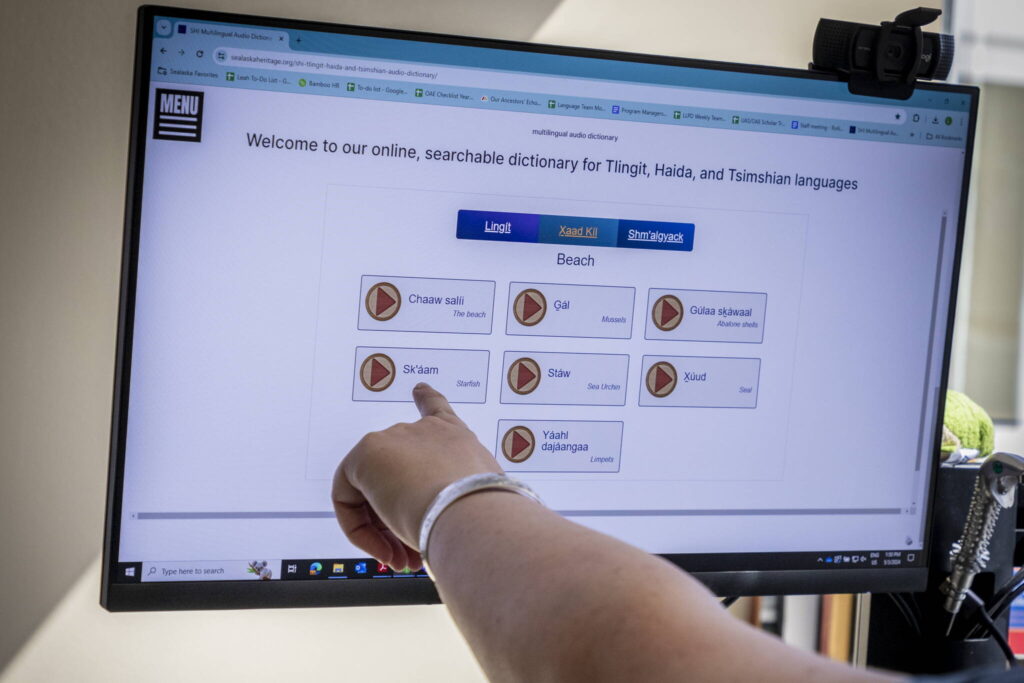
Sealaska Heritage Institute (SHI) has launched a new online dictionary that allows users to search for words and phrases in Lingít (Tlingit language), X̱aad Kíl (Haida language), Shm’algyack (Tsimshian language) and English. Users can browse words and phrases, and listen to heritage language speakers pronouncing the entries.
Notably, users may search the database using English or Native terms to reveal all related content, said SHI President Rosita Worl.
The platform denotes a previously missing language tool that is meant to stand alone or to complement existing materials to help perpetuate Southeast Alaska’s ancient Indigenous languages, she said.
“As a people, we have documented our languages and developed the orthographies for the words that describe our oral histories. We have produced materials to revitalize our languages and apps that allow people to browse categories and hear audio. Now we have a database that offers all of that and includes a search function,” Worl said.
“It’s a game changer.”
The dictionary content mirrors the vocabulary and phrases available on SHI’s Tlingit, Haida and Tsimshian learning apps that were released in recent years.
The Tlingit section includes more than 50 categories for words relating to action, adjectives, animal body parts, beach, birds, birth, buildings and structures, clothing, cold blooded animals, colors, commands, communication, conditions, cultural, direction, fish, food, games, geography, grammar, home, human body, human family, insects and invertebrates, kitchen, land animals, location, mammals, marine animals, marriage, material, matter, minerals, names, numbers, nursery, occupations, people, plants, pronouns, quantity, recreation, relationships, school, sea creatures, sky, sports, stage of life, time, tools, transportation, water and weather.
The Haida section includes nearly 40 categories for words relating to the alphabet, animals, art, bathroom, beach, birds, body parts, buildings and structures, clothing, colors, commands, cultural art, culture, fishing and hunting, home, insects and invertebrates, jewelry, kitchen, location, mammals, numbers, nursery, occupations, ocean, outside, plants, recreation, school, sea creatures, sea vessels, sky, time, tools, transportation, verbs, water, weaving and wellness and health.
The Tsimshian section includes 30 categories for words relating to adjectives, alphabet, bathroom, beach, birds, body, buildings and structures, clothing, colors, culture, days of the week, fish, food, home, insects and invertebrates, kitchen, mammals, months of the year, numbers, nursery, occupations, ocean, plants, pronouns, recreation, school, sea creatures, sky, tools and transportation.
All sections also include audio of phrases listed by category. The dictionary is available free of charge on SHI’s website, along with its other language resources. Staff will continue to expand the dictionary’s words, phrases and associated audio.
SHI has worked on language documentation and perpetuation since the nonprofit’s inception 44 years ago. The institute initially focused on helping to create the orthographies for the languages and worked with heritage language speakers and linguists to develop dictionaries and other books for Lingít, X̱aad Kíl and Shm’algyack.
In the 1990s, SHI’s Board of Trustees made language revitalization a priority. The institute then began to sponsor teaching activities, such as language immersion camps, in which students would live in a habitat of a Native language over a period of days. SHI also poured many resources into developing lessons, videos, flash cards, apps, podcasts and games to enhance the learning experience.
In recent years, SHI has sponsored university classes and scholarships for language learners, and many language teachers today are of a generation who grew up without hearing their Native tongue at home.
No comments:
Post a Comment